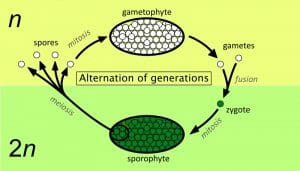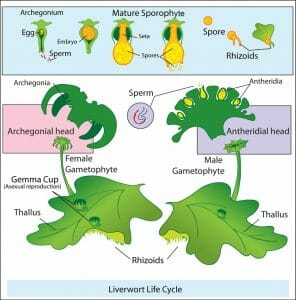Liverworts Definition

Liverworts, like the species seen above, represent a branch of non-vascular plants, most of which are terrestrial. The name “liverworts” is derived from the belief in ancient times that the diseases of the liver could be cured with these plants. Liverworts are part of the kingdom Plantae, in the division Marchantiophyta. While the plants are small, and often overlooked, liverworts can be found globally, wherever plants can grow.
Liverwort Life Cycle
Liverworts, like most plants, display an alternation of generations between a haploid organism and a diploid organism. The general outline of this type of lifecycle can be seen below.
In alternation of generations, a single species displays multiple forms. There is the sporophyte, which is capable of producing haploid spores. These spores cannot fuse together like gametes, and instead they grow into a new organism, the gametophyte. The gametophyte is still haploid, but grows into a multicellular organism. The gametophyte can produce gametes, which are similar to spores except they will not grow into a new organism directly. Instead, gametes undergo fusion or fertilization, and form a new cell, the zygote.
The zygote, now a diploid organism, grows to be multicellular. It develops special organs capable of meiosis, a type of cell division which reduces the amount of DNA. Through this process, the spores produced are haploid, again. This means that they carry only 1 copy of DNA. They are released into the environment, and the process can start over. Sporophytes and gametophytes typically look and form differently, although this is not always the case. In the case of liverworts, the sporophyte and gametophyte versions are very different. Look at the image below.
In liverworts, the gametophyte is the dominant life cycle. This means that liverworts are typically haploid organisms. In the image above, you will see two gametophytes. Liverworts are also dioicous, meaning they have haploid gametophytes with separate sexes. The male plants produce an antheridial head, capable of producing sperm. The female archegonial head produces an egg. The sperm are dispersed from the male gametophytes, and are carried by wind or water to the egg found on another plant.
When the sperm fertilizes the egg, an embryo is formed. This is the sporophyte, and in liverworts it will not get very big. The liverwort sporophyte develops into the microscopic seta. The seta, or mature sporophyte, is completely dependent on the gametophyte for food and survival, and lives within the archegonium its entire life. The seta is responsible for conducting meiosis, and creating the haploid spores. The spores will be released into the environment, and will grow into adult gametophytes. The image shows the development of the first rhizoids on the spore, which will become a rudimentary root system for the grown gametophyte.
In most other terrestrial plants, the opposite of the liverworts is true. Typically, the sporophyte class is the much more represented species. In ferns and all higher vascular plants, the sporophyte is the one we see, while the gametophyte has been heavily reduced. A flower, for example, houses the entire gametophyte in most flowering plants. A single pollen grain is actually the male gametophyte, and produces sperm. The seed which is formed is the zygote, and will produce the sporophyte. Spores are produced, but instead of being released to form large gametophytes, they are retained within the plant to form small gametophytes. These gametophyte individuals then produce gametes, and the process repeats. Liverworts do the opposite of this process.
In compared with human biology, the liverwort lifecycle and alternation of generations can seem very different. However, humans also produce sperm and egg cells, which are haploid. Really, the only difference lies in when and how fertilization takes place. In humans and most other sexually reproducing animals, meiosis leads to single cells which undergo fertilization and create a new organism. In the alternation of generations, there is simply another step after meiosis. In this step, the haploid cell undergoes mitosis, growing into a multicellular organism. This structure or organism then produces the gametes, which can fuse together to create a zygote.
However, this is not the only way liverworts can reproduce. Take a look at the image above again. You will notice that the gametophytes both have small cups, called gemma cups. These cups contain small clusters of cells known as gemmae. When rain or water spashes into the cup, the gemmae are dispersed from the plant, and are capable of growing into full gametophytes in the right conditions. While liverworts have the ability to reproduce through the above mentioned process of alternation of generations, this much simpler process of asexual reproduction probably accounts for a large percentage of the plant’s reproduction and dispersal.
Evolutionary History of Liverworts
Like all terrestrial plants, vascular and non-vascular, liverworts appear to have their beginnings in the Ordovician period, the second of six Paleozoic Era periods. Nearly 485 million years ago, the Cambrian period came to a close, as the Ordovician opened. At this time, shallow seas covered much of a landmass known as Gondwana, a continent composed of modern Africa, South America, India, and Antarctica. The shallow sea supposedly allowed the development of the first non-vascular plants, including descendants of liverwort.
The emergence of the embryophytes, or land plants, greatly changed the atmosphere of the early world. The atmosphere was composed heavily of carbon dioxide, and contained little oxygen. As plants like ancient liverworts began to emerge, they consumed the carbon dioxide and released oxygen. This drastic changing of global chemistry would later lead to climate change and massive extinction events. Unlike liverwort, vascular plants had a distinct advantage in transporting and holding water. However, in the 485 million years since the emergence of land plants, both types have colonized nearly every terrestrial space. Liverworts and other non-vascular plants can be found in deserts, and in cold northern latitudes as well.
Liverworts, once thought to be firmly related to the ferns, have more recently been given their own subdivision. The ferns show an opposing alternation of generations. Unlike liverworts, they show a dominate sporophyte. It is now thought that ferns are more closely related to gymnosperms (conifers) and flowering plants. Liverworts, therefore, represent an ancient and mostly unchanged division of some of the first terrestrial organisms to ever come out of the water. The argument of whether to include the liverworts within the Bryophyte (moss) grouping is an ongoing debate, but recent classifications have kept them in their own division.
Quiz
1. Which of the following structures produces gametes within liverworts?
A. Spore
B. Gametophyte
C. Sporophyte
2. Why are the liverworts considered closely related to moss?
A. They aren’t closely related
B. They are both plants
C. They are both non-vascular and exhibit an alternation of generations
3. Which of the following most accurately describes the liverwort life cycle?
A. Alternation of Generations with Sporophyte dominance
B. Sexual reproduction alone
C. Asexual reproduction and Sexual reproduction through alternating generations, featuring a dominant gametophyte
References
- McMahon, M. J., Kofranek, A. M., & Rubatzky, V. E. (2011). Plant Science: Growth, Development, and Utilization of Cultivated Plants (5th ed.). Boston: Prentince Hall.
- Reece, J. B., Urry, L. A., Cain, M. L., Wasserman, S. A., Minorsky, P. V., & Jackson, R. B. (2014). Campbell Biology, Tenth Edition (Vol. 1). Boston: Pearson Learning Solutions.
- Rubinstein, C. V., Gerrienne, P., de la Puente, G., Astini, R. A., & Steemans, P. (2010). Early Middle Ordovician evidence for land plants in Argentina (eastern Gondwana). New Phytologist, 188(2).
Liverworts
No comments:
Post a Comment